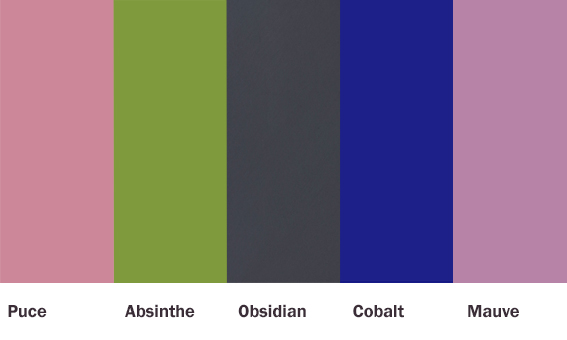Dead Salmon, Racing Green, Twilight Teaser – what do colour names mean to you?
Depending on your interests, Rosso Corsa may mean more than Elephant’s Breath but there is one huge evocative rainbow out there in the world.
A colour by any other name
So if I say red, you know what I mean.
But if I say scarlet, or crimson, or claret, you know exactly what I mean.
And it’s the stories behind the names of colours that I find so fascinating. There is an intriguing condition of synethesia, where letters and numbers are perceived as colours. Cue endless hours staring into space, trying to summon my inner synethesia.
Naming colours used to be quite a literal occupation. So, Bone White was made by burning bones and using the powder that produced.
But others have far more prosaic stories. Sepia is produced from ink sacs of the cuttlefish. Cochineal by crushing a female insect that feeds on the red berries of a cactus.
Tyrian Purple, worn by Roman caesars, was made from crushed shellfish and was notoriously expensive. As it took 10,000 of the little molluscs to make a gramme of dye, it’s not that surprising.
Some names hide more disgusting tales. Indian Yellow was particularly luminous, as it fluoresces slightly. Lovely, no? But it was produced by heating the urine of cattle fed on mango leaves, a cruel process ultimately banned in 1908.
Modern hue
The modern world has continued with this prosaic art of naming colours, mixing accuracy with a hint of aspiration and a liberal sprinkling of optimistic PR.
The beauty world reigned supreme in the 1980s with lipsticks in shades of Pinking Shear and Twilight Teaser. An image forever lingers in my mind of frosted lips pouting through a thicket of badly permed hair, with over-underlined eyes.
It raged on through the 1990s with such classics as Rouge Noir, onto Ruby Woo and Russian Red, before it all jumped the shark.
I am a big fan of a pun. I’ll let them away with Taupe-less Beach and Tiny Wine-y. But what colour exactly is Girls Love Ponies? Or (shudder) Deep Throat, Corduroy or Marshmallow Bunny?
Even the motor industry showed it wasn’t immune. The Tangerine Scream Ford Focus ST toppled the classy and classic Estoril Blue and Rosso Corsa (from BMW and Ferrari respectively) from the colour rostrum in the 21st century.
Hint of a tint
Attention wandered to interior décor, as it took up the mantle of quirky colour names.
Move over Magnolia, here comes Mown Grass.
It became all about Alabaster and French Grey, Calm Clouds and Vintage Chandelier.
Now, I’m in no way immune to a clever and quirky colour names. My entire house colour scheme seems to have been chosen by name. Christmas pudding, anyone? Magpie? Wasabi chocolate?
Let’s say I’m glad that Mole’s Breath is an evocative name and not from the literal tradition of Bone White.
But it was when I was slapping Celebrity on the walls that I realised paint names may also have jumped the shark. It’s only a matter of time before I’m painting the hall in Corduroy.
- Hoolet is a strategic communications consultancy. Come say hello on Twitter at @hoolet_hoots, or follow us on LinkedIn. You can read more blogs here.
Here are some classic colours with evocative names. Feel free to add your own favourite colour names in the comments section below…
Thanks to Kassia St Clair and her excellent book The Secret Lives of Colours for the history behind the names.

Puce
As discontent was sliding into revolution in 18th century France, a frankly oblivious Marie-Antoinette was trying on her latest gown. It was made of glossy silk taffeta in a strange shade somewhere between brown, pink and grey. Her husband King Louis XVI observed it was the colour of fleas (couleur de puce). You could ask for a more constructive comment from a spouse but the name stuck and the French court was soon awash with ladies dressed in this newest and most chic shade of “flea”.

Absinthe
A bitter, pear-coloured liqueur infamous in the late 19th century, this drink was initially considered medicinal. However, its growing popularity – served diluted with ice-cold water poured through an ice cube – meant it became notorious, described as “an emerald-tinted poison”, and eventually leading to its banning across Europe. Apparently it is not poisonous at all, just very alcoholic. But despite a recent resurgence this slightly lurid green lives on in the palette rather than palate.

Obsidian
Also known as volcanic glass, obsidian is formed when molten lava comes into contact with ice or snow and cools very quickly. The Aztecs polished it up to make mirrors to honour their gods, and its association with the other-worldly has continued. It was used to slay the White Walkers in Game of Thrones. A “shade” of black, pure obsidian usually appears to be dark, although the color may vary depending on the presence of impurities. Nike’s version of obsidian is decidedly navy.

Cobalt
While cobalt is a chemical element with the symbol Co and atomic number 27, cobalt blue was created as a synthetic alternative to ultramarine. Described by chemist and author George Field as “the modern improved blue … neither tending to green nor purple, and approaching in brilliancy the finest ultramarine”, it is a mixed oxide of cobalt and aluminium. Created in 1802 by a French chemist, cobalt has been used since the Middle Ages, by the Sevres potters in their blue glazes, in the sky-coloured tiles in Persian mosques and in the medieval iris-blue glass at Chartres.

Mauve
We have a lot of things to thank gin and tonic for, not least this cool-hued shade of purple. It was while trying to make a synthetic form of quinine from coal tar – to be fair, to treat malaria, rather than top his favourite tipple – that William Perkin produced a reddish powder. Rather than shuffling it into the bin, William added water, dipped some silk in and realized he’d made a light and wash proof purple dye. He named it mauve, after the French name for the mallow plant, which is a similar colour.

